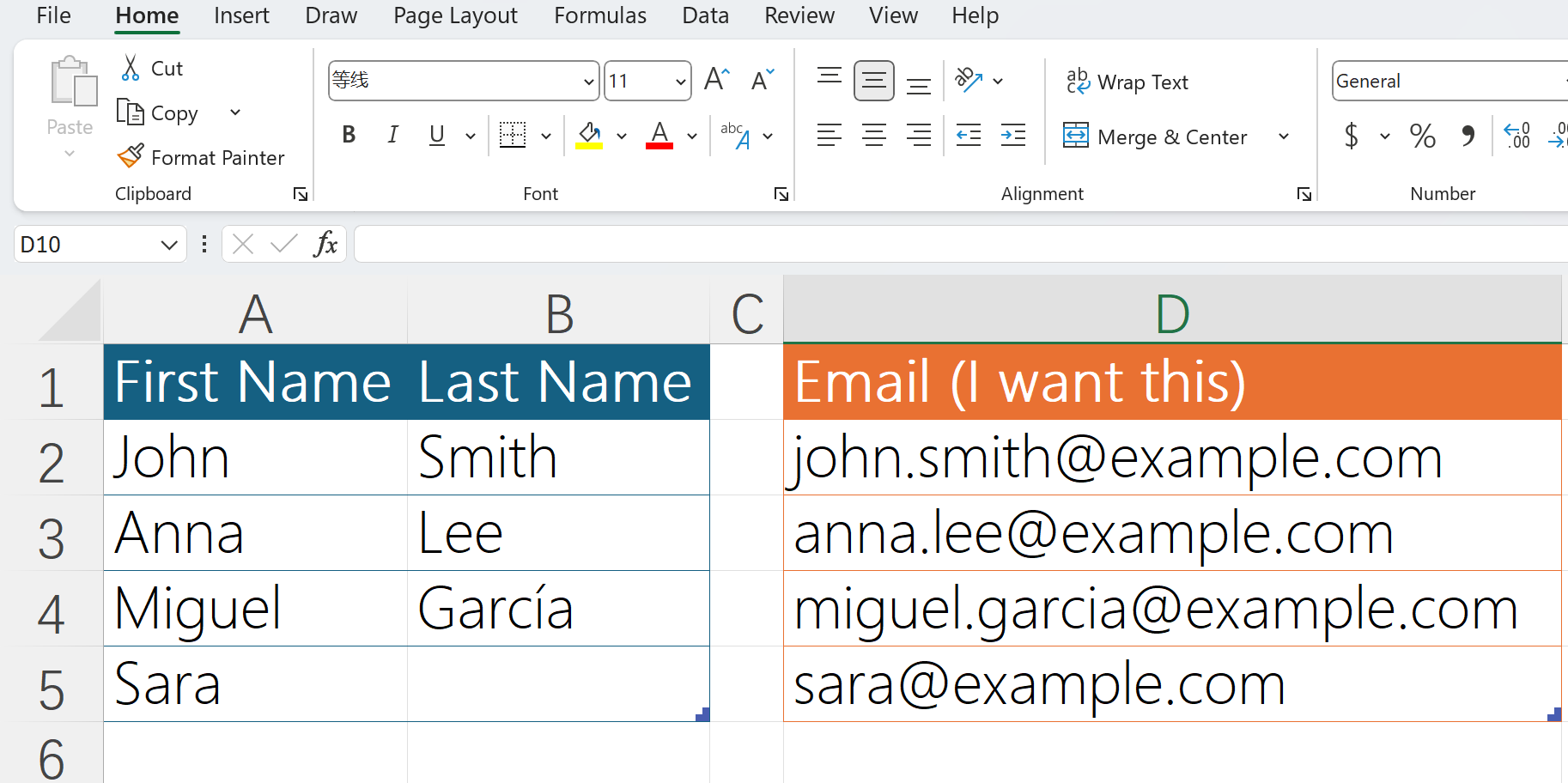Merging first and last names into a single Full Name column is a common cleanup step before exports, reports, or mailings. Typical situations include preparing contact lists for email campaigns, creating attendee badges, preparing CRM or HR imports, matching records across systems, formatting certificates, and generating shipping contacts. You might also need different output styles like "First Last", "Last, First", or initials for display names.
Sample dataset
Assume you have a simple two-column table in a worksheet named Sheet1. First name is in column A and last name is in column B, starting from row 2.

In formulas below, the first data row is row 2 (A2 and B2), and the list continues down the sheet.
Quick methods to merge names
1) Use the ampersand operator (fast and simple)
Concatenate with a space between names:=A2 & " " & B2
This results in "John Smith". If B2 is blank you'll get an extra trailing space, in this case, it's "Sara ".
2) Use CONCAT or CONCATENATE
Older Excel:=CONCATENATE(A2, " ", B2)
Newer Excel:=CONCAT(A2, " ", B2)
Both behave like the ampersand method. CONCAT is the modern replacement for CONCATENATE. If B2 is blank you'll get an extra trailing space too.
3) Use TEXTJOIN to ignore blanks (recommended when some names are missing)
=TEXTJOIN(" ", TRUE, A5, B5)
This returns "Sara" for the row where Last Name is blank, instead of "Sara ".
4) Trim extra spaces and fix capitalization
To remove accidental extra spaces and make each name Proper Case:=PROPER(TRIM(A2 & " " & B2))
Or combined with TEXTJOIN:=PROPER(TRIM(TEXTJOIN(" ", TRUE, A2, B2)))
5) Format as "Last, First"
=B2 & ", " & A2
Useful for sorting or display formats like "Smith, John".
6) Create initials
First and last initial: =LEFT(A2,1) & LEFT(B2,1), which display like "SJ".
With periods: =LEFT(A2,1) & "." & LEFT(B2,1) & ".", which display like "J.S.".
7) Handle conditional blanks with IF
If you prefer explicit handling:=IF(B2="",A2, A2 & " " & B2)
But TEXTJOIN(" ", TRUE, ...) usually does this more cleanly.
Other approaches (no formulas required)
Type the desired output in the first cell of the Full Name column (for example, type "John Smith" in C2), then select the remaining column and press Ctrl+E. Excel will auto-detect the pattern and fill the column.
Dealing with messy real-world data
Names often include extra spaces, mixed casing, prefixes or suffixes, middle names, or special characters. Here are practical tips:
- Use
TRIMto remove leading, trailing, or double spaces. - Use
PROPERto normalize capitalization, but be careful with names that require special casing like "McDonald" or all-caps acronyms. - Use
TEXTJOINto skip empty pieces (middle names, suffixes). - For complex normalization across thousands of rows or multiple rules, manual formulas get cumbersome.
When to use AskExcel instead
AskExcel lets you upload your Excel or CSV and use plain language requests to clean and merge names for you. Instead of building and debugging long nested formulas or Power Query steps, you can say things like:
"Create a Full Name column by combining First Name and Last Name, remove extra spaces, convert names to Proper Case, and also add a Display Name column formatted as 'Last, First'."
AskExcel will apply the transformations, handle missing values, and return the cleaned table you can download. Use AskExcel when your dataset is large, messy, or when you need multiple, repeatable rules like removing prefixes, splitting compound last names, or generating several name formats at once. For quick single-column merges on a small clean sheet, regular formulas or Flash Fill are often faster.
Short checklist before you merge
- Confirm which columns hold first and last names and whether there are middle names or suffixes.
- Decide output format: "First Last", "Last, First", initials, etc.
- Trim spaces and standardize casing after merging.
- For repeated processes or many exceptions, prefer AskExcel.
Example: apply formula across a column
If you choose the TEXTJOIN + PROPER approach, enter the following in C2 and copy down:=PROPER(TRIM(TEXTJOIN(" ", TRUE, A2, B2)))
This yields clean names like "John Smith" and "Sara" (for missing last name).
Summary
Merging First and Last Name in Excel can be as simple as =A2 & " " & B2 or as robust as =PROPER(TRIM(TEXTJOIN(" ", TRUE, A2, B2))). Use Flash Fill for one-off or repeatable transformations, and consider AskExcel when you want a fast, no-formula solution that cleans and formats names at scale with plain-language instructions.
